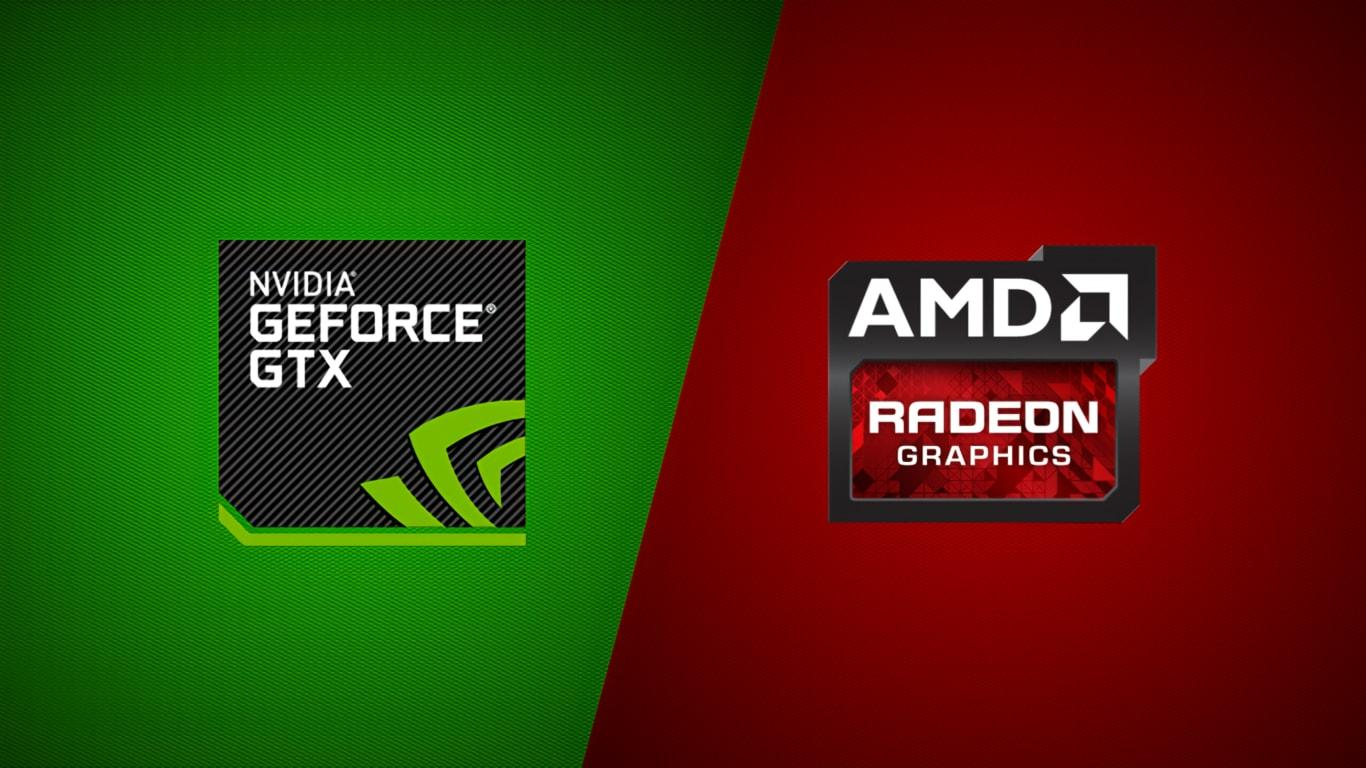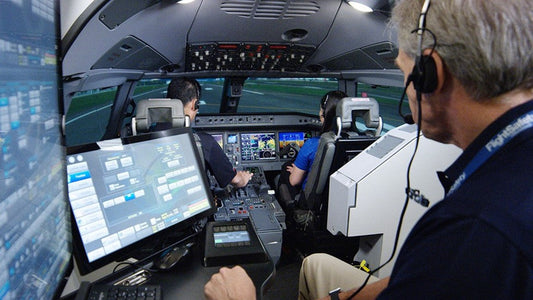The Best Graphics Cards for SimulatoThe Best Graphics Cards for Simulatorsrs

Figure 1: Nvidia GPUs vs AMD GPUs
When selecting the best graphic cards for simulators, several factors must be carefully weighed to ensure an optimal experience. Ask yourself questions like do you have a multiple monitor set up or a single high-resolution display? Do you have adequate cooling installed to ensure that whatever GPU you choose does not get overheated? What resolution do you prefer: 1080p, 1440p, or 4K?
In this buyer guide, we walk you through the list of the best graphic cards for simulators currently available in the market. Whether it’s for flight sims, racing sims, or other immersive experiences, we’ve got you covered. Let’s get started!
Nvidia GeForce RTX 4090
 Figure 2: RTX 4090 Nvidia Cover Art
Figure 2: RTX 4090 Nvidia Cover Art
Topping our charts is no other than the world’s currently most powerful consumer-level gaming GPU, the RTX 4090. It is practically a powerhouse capable of running the most demanding simulation titles at the smoothest frame rates possible!
Built on Nvidia's latest Ada Lovelace architecture, this $1599 monster GPU boasts a whopping 16,384 CUDA cores and 24GB of GDDR6X VRAM. It features an ultrawide 384-bit bus width with a base clock of 2,235 MHz which can be further boosted to a clock speed of 2,520 MHz. Out of the box, the Nvidia GeForce RTX 4090 measures approximately 336 mm in length and comes with three DisplayPort 1.4a and one HDMI 2.1 port.

Figure 3: Microsoft Flight Simulator 2020 at 4K Ultra Settings
With such a holy combination of beefy specs, RTX 4090 delivers a solid 60 FPS native experience at 4K ultra settings across all simulation games, including the most demanding Microsoft Flight Simulator 2020. And when FG comes into play, the FPS can soar all the way up to 144 and even above. It offers similar other stunning benchmarks in racing simulation games like iRacing and Assetto Corsa.
Our take on this GPU: RTX 4090 is a very capable 4K card but only go with it if your budget allows it and make sure that your other PC components do not bottleneck it, otherwise you won’t be getting the maximum performance out of this card and thus waste your money.
AMD Radeon RX 7900 XTX
 Figure 4: AMD RX 7900 XTX Cover Art
Figure 4: AMD RX 7900 XTX Cover Art
If not for Nvidia’s GeForce RTX 4090, AMD’s Radeon RX 7900 XTX would have secured the first position on our list of the best graphic cards for simulators. So don’t let its second place fool you into doubting its true capabilities. A major advantage of this AMD GPU over 4090 is its three-digit price tag of $999.
RX 7900 XTX is built on RDNA 3 architecture and features 6,144 steam processors alongside 24GB of GDDR6 video memory (VRAM). Its key specifications include a base clock of 1,900 MHz with a boost clock up to 2,500 MHz. The memory bus width is the same as the 4090’s, i.e., 384-bit. With support for 2 HDMI 2.1 ports and two DisplayPort 2.1 ports, the beast of a GPU measures 287mm in length which makes it a bit more portable than 4090.

Figure 5: Assetto Corsa Competizione at 4K Ultra Settings
These specs let RX 7900 XTX run almost every AAA sim game at 4K 60 FPS at ultra settings. In Assetto Corsa Competizione, for instance, it can easily hit 100+ FPS at native 4K resolution on ultra preset without breaking a sweat! Similar 4K benchmarks can also be seen in other sim flight and sim racing games with this beefy GPU.
Our take on this GPU: If RTX 4090’s TDP have you second-guessing the GPU, then AMD Radeon RX 7900 XTX shines out here. With 100W less power consumption, it offers an almost identical experience as that of 4090 and that, too, at a $600 reduced price tag!
Nvidia GeForce RTX 4080
 Figure 6: RTX 4080 Nvidia Cover Art
Figure 6: RTX 4080 Nvidia Cover Art
Next on our list is no other than the second-best Nvidia graphic card: the RTX 4080. It is a cutting-edge modern high-performance GPU for simulation gaming in 2024 and beyond. Although released alongside 4090, the Nvidia GeForce RTX 4080 comes at a much more favorable performance-to-cost ratio.
As with every other RTX 40 series GPU, the 4080 is also built on the highly efficient Nvidia’s Ada Lovelace architecture. In that, it features 9,728 CUDA cores and comes equipped with 16GB of GDDR6X VRAM. With a 256-bit memory bus width, RTX 4080 has a base clock speed of 2,205 MHz and a further 2,505 MHz boost clock speed. Other key specs include an approximate 304mm length, 320W TDP, and support for three DisplayPort 1.4a and one HDMI 2.1 port.

Figure 7: Assetto Corsa Competizione at 1440p Epic Settings
As seen above, RTX 4080 is a solid 4K monstrous GPU but it has about 33% less VRAM. However, it is not much of an issue. While 24GB VRAM sounds great, know that you’re perfectly fine with 16 gigs of video memory on RTX 4080. The majority of modern sim games, like X-Plane 12 and rFactor 2, presently consume around 7-9 GB VRAM anyway.
AMD Radeon RX 7800 XT
 Figure 8: AMD RX 7800 XT Cover Art
Figure 8: AMD RX 7800 XT Cover Art
Falling short by just one sport to join the company of the top 3 is AMD’s Radeon RX 7800 XT. While we could have concluded the article with the top 3 high-performance GPUs for simulation gaming, we couldn’t help but mention RX 7800 XT, a strong contender in the race of best graphic cards for simulators.
While this GPU bags the fourth place, it shows up to the party with compelling specs that come at an equally competitive price point. Right out of the box, RX 7800 XT features 60 compute units and 16GB of GDDR6 VRAM. It is built on AMD’s RDNA 3 architecture and comes with a base clock of 1495 MHz which can further be boosted to 2,430 MHz on a 256-bit memory bus width. It measures approximately 267mm in length and supports three DisplayPort 2.1 ports and one HDMI 2.1 port.

Figure 9: Microsoft Flight Simulator at 1440p Ultra Settings
It should be noted that although RX 7800 XT is marketed as a 1440p card, it can also handle 4K games at ultra presets with ease. While it outperforms its competitors at 1440p in demanding games like Microsoft Flight Simulator 2020, it can also run them at 4K with FSR upscaling to achieve a smoother 45-60 FPS experience at maximum settings.
Our take on this GPU: RX 7800 XT is a great high-value graphic card for running simulation games at maximum settings at 1440p. You can even game at 4K with high frames, provided you enable FSR upscaling. Thanks to its 16GB video memory at such as price point, you don’t have to worry about running out of VRAM for the next 2-3 years.
Final Thoughts
These are the best graphic cards for simulators in 2024 which are currently available in the market. Even with the RTX 50 series on the horizon, followed by the next generation of AMD GPUs shortly afterwards; these GPUs listed will stay relevant in the long run.What do you think? Share your thoughts with us and let us know in the comments down below!





